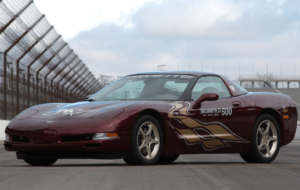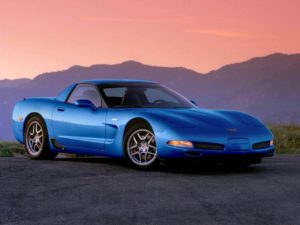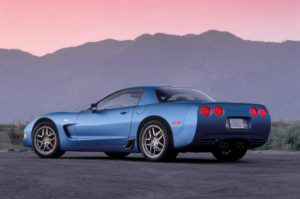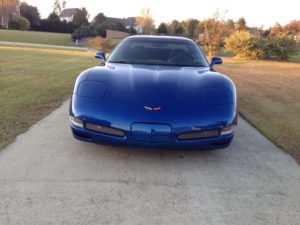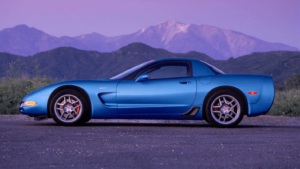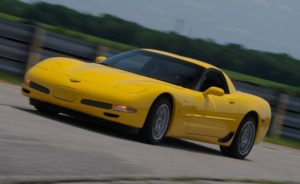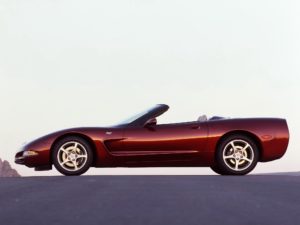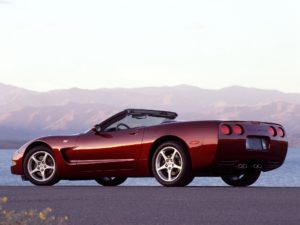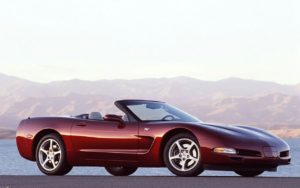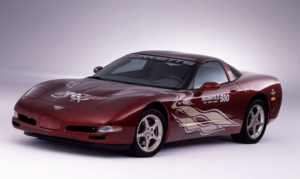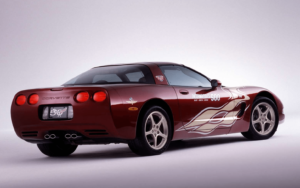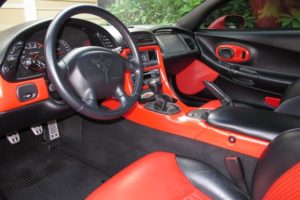Pricing: $41,540 (Coupe), $47,975 (Convertible), $50,150 (Z06)
Engine options: LS1, 346 C.I., 5.7 Litre V8 (Coupe/Convertible), LS6, 346 C.I., 5.7 Litre V8 (Z06)
Transmission: 4-speed automatic (standard), 6-speed manual (optional)
Top speed: 171mph (Z06), 175mph (coupe, convertible)
Units Produced: 35,767
Available Colors: Light Pewter, Quicksilver, Electron Blue, Speedway White, Black, Torch Red, Millenium Yellow, Magnetic Sunrise
Highlights of the year:
The Z06 had become the primary focal point for most of the engineering advances made to the Corvette in 2002.
Perhaps because the coupe and convertible had already been refined during the first several years of its production run, the evolution of the C5 line as a whole now seemed to be centered around advances being made around the Z06 – and it was a decision that GM was certain would pay off.
Last year’s introduction of the Z06 Corvette, based on the former hardtop model and the legendary 1960s Z06 option package, was aimed at true performance enthusiasts at the upper end of the high-performance market. And now with an extra boost of 20 hp, to 405, makes Z06 became the quickest production Corvette ever (at that time)
This upgrade to the LS6 engine’s output is the result of new hollow stem valves, a higher-lift camshaft, a low restriction mass airflow (MAF) sensor, and a new low restriction air cleaner design. Eliminating the PUP converter from the exhaust system enables better flow of spent gasses and reduces vehicle weight, without compromising Corvette’s NLEV (National Low Emission Vehicle) status.
Of course, producing the level of power that the new LS6 equipped Z06 was now capable of would require modifications to other areas of the car. To withstand the additional engine torque, the Z06 received a redesigned clutch. The modifications to the existing clutch included the use of premium alloy wire during fabrication of the damper springs and the design of the damper springs were actually changed to increase the clutch wind-up rate. Lastly, the flange-late thickness was increased by 20 percent. In all, these improvements would provide drivers with improved overall performance and added durability to the clutch.
The Z06-specific FE4 High-Performance suspension system featured a larger front stabilizer bar, a stiffer rear leaf spring and specific camber settings – all calibrated for maximum control during high-speed operation. The Z06 also came with new rear shock valving for a more controlled ride.
There were also changes to the convertible and coupe.
Minor changes were introduced which included the introduction of an in-dash AM/FM/CD player which was now standard on both coupes and convertibles except in those instances when the car was sold with the optional 12-disc CD changer. In such instances, the factory-installed stereo head unit would continue to include the AM/FM/cassette unit.
For those Corvettes equipped with an automatic transmission, they would receive a lighter-weight transmission cooler case that was now manufactured out of cast aluminum instead of stainless steel. To help with weight-savings, all 2002 Corvette Convertibles equipped with a Heads Up Display (HUD) received a slightly thinner, 4.8mm thick windshield (as compared to the previous 5.4mm that had been standard on all Corvettes prior to 2002.) This thinner windshield would provide a weight savings of 2.65 lbs per car.
Beyond being a serious contender on the race track, the 2002 Corvette was once again bestowed with the honor of being the official pace car at the 2002 running of the Indianapolis 500. On May 26, 2002, the Chevy Corvette led the open-wheel race cars around all of the inaugural laps of the Indy 500, representing Corvette’s fifth appearance at the historic racing event.
Photos of the 2002 Corvette:
Sources:
https://www.corvettemuseum.org/learn/about-corvette/corvette-specs/2002-corvette-specs/
https://www.corvsport.com/2002-c5-corvette/
https://www.corvsport.com/2002-c5-corvette-image-gallery/
